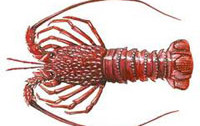
Mytilus galloprovincialis, Perna perna and Semimytilus algosus
Mussels are fast becoming South Africa’s biggest source of income from marine products and the industry is gaining a considerable export market. Mussels are marine molluscs of the class Pelecypoda, which means hatchet-foot. They are bivalves, having a shell consisting of two valves, or movable pieces, hinged by an elastic ligament.
Within the shell there is a fleshy layer of tissue called the mantle with a cavity (the mantle cavity) between the mantle and the body wall proper. The mantle secretes the layers of the shell, including the inner nacreous, or pearly, layer. Nacreous layers can also be formed around a foreign body in reaction to irritation. A muscular hatchet-shaped foot projects from the front end of the mollusc, between the valves. This foot is used for burrowing, and, in some bivalves (e.g., razor clams), to swim. Bivalves differ in their habits: some, such as the oysters and marine mussels, have a reduced foot and are permanently attached to a substratum. Most of the body consists of the reproductive organ – orange in females and white in males. During reproduction they shed enormous numbers of egg and sperm into the water.
In addition to being an important food source for ourselves, bivalves, which include clams, cockles, oysters, and scallops, as well as mussels, are also an important part of the diet of gastropods, fish, and shore birds. The fertile waters of the Benguela Current, with its high concentrations of plankton, make the region an excellent natural breeding-ground for mussels.
The Mediterranean blue mussel, Mytilus galloprovincialis, grows up to 7.6 cm and is common along the Atlantic coast. It was introduced to the west coast of South Africa from Europe in the late 1970′s to be raised commercially. It has now become invasive and is the dominant intertidal mussel species throughout the ecoregion, where it has displaced the indigenous mussel, Aulacomya ater. In comparison with the indigenous mussel species, the Mediterranean blue mussel displays several characteristics of an aggressive invasive alien: it grows rapidly at differing water temperatures; it is highly reproductive; it is resistant to desiccation and it is resistant to parasites. It is demonstrably out-competes native species for primary space in the region. In addition, its reported ability to grow rapidly in the warmer waters of Port Elizabeth suggest that this invader has the potential to become invasive on the south and east coasts of South Africa as well.
The brown mussel, Perna perna is the dominant mussel species on the south and east coasts of South Africa. It is virtually absent on the central and southern parts of the west coast , where Mediterranean blue mussel is dominant, and it reappears as the dominant species in northern Namibia. However these two species are similar in habit, therefore any interaction between them intertidally is likely to be more evenly balanced than that between Mediterranean blue and Aulacomya.
The brown mussel is a relatively elongate, low-shelled bivalve, easily recognised by its brown colour. The shell is thin around the edges and thickens posteriorly. The maximum shell size is influenced by vertical distribution. In intertidal zones, the mussel reaches a maximum size of 90mm. And, a maximum size of 120mm is reached at lower depths.
Another member of the same family, Semimytilus algosus, is widely distributed from Africa to Conception, Chile, where it is known as the chorito or green chorito. Beds of these mussels provide an important habitat for a range of organisms, particularly polychaetes (marine worms). This edible bivalve is somewhat angular, with dark brown colouration.








Social Profiles